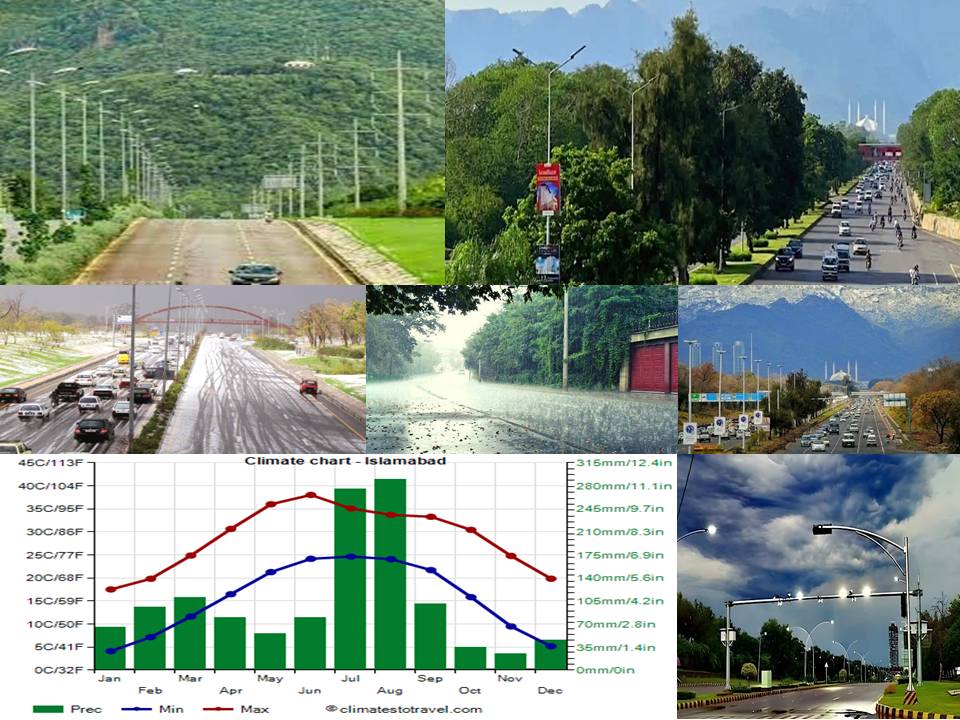Introduction
Every city has unique climate conditions that shape how buildings should be designed and constructed. Islamabad, with its hot summers, monsoon rains, and cold winters, presents both challenges and opportunities for builders and homeowners. Ignoring the local weather during construction can lead to higher maintenance costs, poor energy efficiency, and reduced building life span.
At Gemcon Engineering, we specialize in designing and constructing buildings that adapt to Pakistan’s diverse climate conditions. In this blog, we’ll explore how Islamabad’s weather affects construction and share best practices to ensure your building stands strong, comfortable, and sustainable year-round.
Understanding Islamabad’s Climate
Islamabad experiences a humid subtropical climate with distinct weather patterns:
- Hot Summers (April–June) with temperatures reaching above 40°C.
- Monsoon Season (July–September) with heavy rains causing flooding and moisture-related issues.
- Cold Winters (December–February) with temperatures dropping near freezing.
- Mild Spring & Autumn offering short transitional seasons.
These seasonal shifts mean that buildings in Islamabad must be resilient to heat, rain, and cold — all while providing comfort to occupants.
How Climate Impacts Buildings in Islamabad
1. Heat Stress in Summers
High summer temperatures can cause:
- Expansion of concrete and steel.
- Faster deterioration of roofing materials.
- Increased cooling costs due to poor insulation.
2. Moisture and Monsoon Challenges
Heavy rainfall in monsoon months leads to:
- Water seepage in walls and basements.
- Mold growth due to high humidity.
- Erosion of poorly protected foundations.
3. Cold Weather Effects
During winter, buildings face:
- Cracks in walls due to contraction of materials.
- Higher heating costs if insulation is inadequate.
- Condensation issues inside poorly ventilated homes.
4. Long-Term Wear & Tear
Islamabad’s mix of hot, wet, and cold weather accelerates the aging of construction materials if not properly planned.
Best Practices for Building in Islamabad’s Climate
1. Use Climate-Resilient Materials
- Concrete mix design should be adapted to handle temperature variations.
- Moisture-resistant paints and sealants protect walls during monsoons.
- Insulated bricks and blocks reduce heat transfer in summer and retain warmth in winter.
2. Effective Roofing Solutions
- Install heat-reflective roofing sheets or tiles to reduce heat absorption.
- Use waterproofing membranes to prevent leaks during heavy rains.
- Add roof insulation to maintain temperature balance inside the building.
3. Smart Insulation & Ventilation
- Double-glazed windows help control indoor temperatures.
- Wall insulation prevents excessive heat gain in summer and retains warmth in winter.
- Cross-ventilation design ensures fresh airflow and reduces cooling load.
4. Rainwater Management
- Proper drainage systems are essential to handle heavy monsoon rains.
- Rainwater harvesting systems can be integrated to reduce water waste.
- Sloped roofs prevent water stagnation and leakage.
5. Earthquake-Resistant Design
Although not directly related to climate, Islamabad is located in a seismic zone. Combining climate-resilient designs with earthquake safety ensures maximum durability.
6. Energy-Efficient Design
- Install solar panels to reduce dependency on the grid.
- Use LED lighting and natural daylight planning to cut energy costs.
- Opt for green building techniques to minimize long-term environmental impact.
Benefits of Climate-Responsive Construction
- Lower Maintenance Costs: Durable materials reduce frequent repairs.
- Energy Savings: Better insulation and design reduce electricity bills.
- Enhanced Comfort: Homes remain cool in summer and warm in winter.
- Sustainability: Reduces the building’s environmental footprint.
- Increased Property Value: Buyers prefer properties designed for local weather challenges.
How Gemcon Engineering Helps
At Gemcon Engineering, we understand the local climate and integrate modern engineering techniques to build structures that last. Our approach includes:
- Tailored material selection for durability.
- 3D architectural planning to visualize climate-responsive designs.
- Expert construction services with waterproofing, insulation, and ventilation solutions.
- Commitment to sustainable, energy-efficient designs for modern living.
By aligning our projects with Islamabad’s weather conditions, we not only ensure structural safety but also guarantee long-term comfort and satisfaction for our clients.
Conclusion
Climate plays a decisive role in the performance and durability of any building. In Islamabad, where summers are scorching, monsoons are intense, and winters are chilly, designing with weather in mind is not an option — it’s a necessity.
By following best practices such as using climate-resilient materials, installing proper insulation, managing rainwater effectively, and investing in energy-efficient solutions, buildings can withstand harsh conditions while providing comfort year-round.
Partnering with experts like Gemcon Engineering ensures your project is not only climate-ready but also cost-efficient and future-proof.

